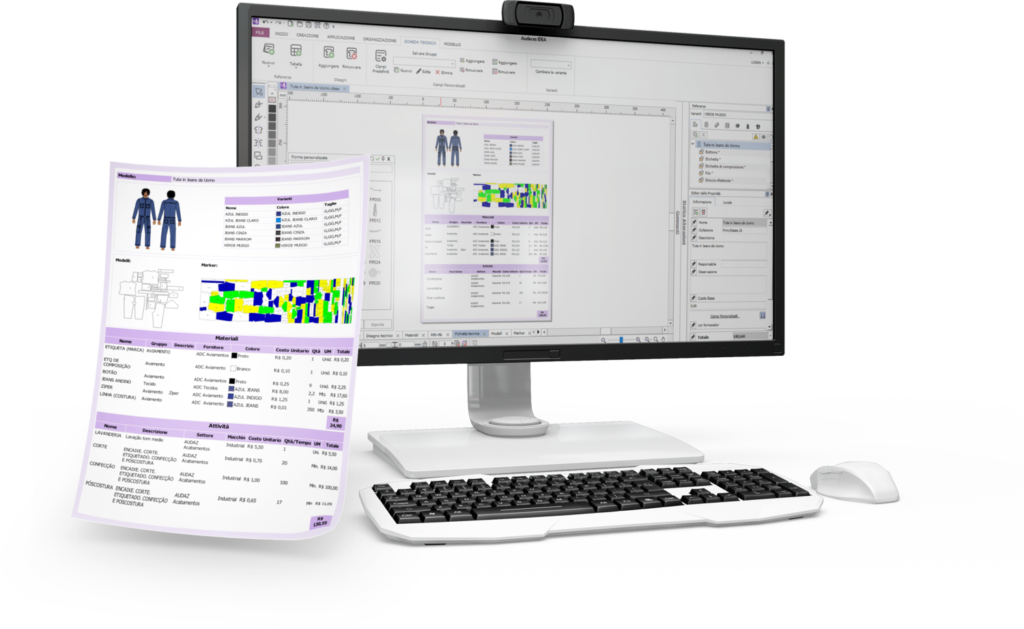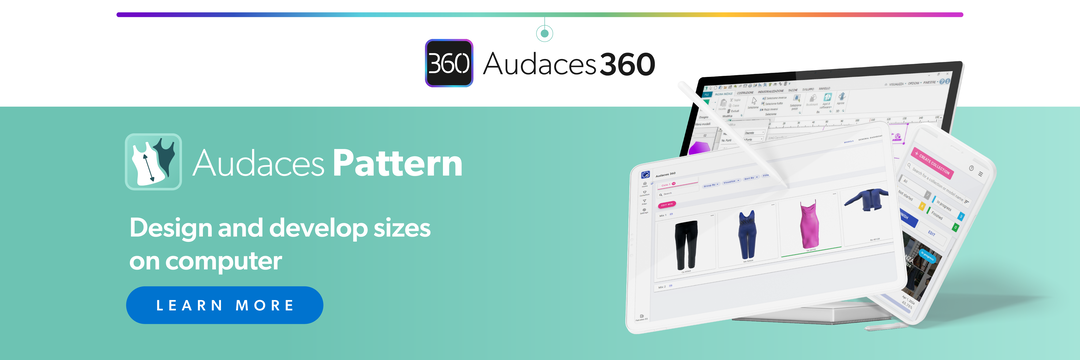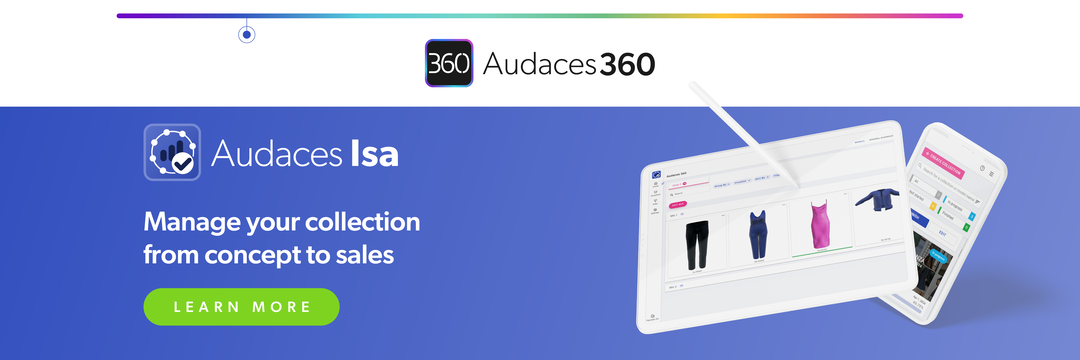Summary
- Discover how to build a clothing size chart that fits your customers perfectly.
- Understand why a well-structured chart improves consistency and comfort.
- Want more industry insights and actionable tips? Subscribe to our newsletter!
A clothing size chart is one of the most powerful tools a pattern maker can create. It defines how your garments fit, move, and connect with the people who wear them. When it reflects real body measurements, production runs smoother and fitting issues fade away.
Customers can notice the difference too! A well-designed size chart turns uncertainty into trust. They know what to expect, and that confidence keeps them coming back for more.
In this article, you’ll learn how to build your own clothing size chart, why it matters, and how innovation can make it smarter.
Happy reading!
Sumário
What is a clothing size chart?
A clothing size chart is a reference guide that defines the body measurements your brand will use for each size. It connects pattern making, grading, and production to ensure that garments fit consistently across your entire collection.
Rather than being a generic table, it reflects your brand’s identity. You can show how you want your clothes to look and feel on customers.
A well-developed size chart helps transform creative ideas into wearable designs. It establishes the proportions that guide every pattern, ensuring balance and comfort in each size. By aligning design intent with technical precision, the chart becomes key for creating clothes that enhance your customers’ confidence.
Types of clothing size charts
There’s no single formula for a size chart: different markets, body shapes, and product categories require different approaches.
The most common types are standard, custom, and regional charts, each with its own purpose and strategy. Choosing the right one depends on your audience and brand positioning.
- Standard size chart: Based on widely accepted measurements such as ASTM or ISO standards. Ideal for brands that produce large volumes or sell internationally. This is because it aligns with common market expectations and simplifies production.
- Custom or brand-specific size chart: Built from real data gathered from your own customers or fitting sessions. It reflects your target audience’s unique proportions, offering a more precise fit.
- Regional size chart: Adapted for different geographic markets, considering variations in body shapes and cultural preferences. Useful for brands that operate globally and want to provide consistent comfort and inclusivity across regions.
Read more: Discover the benefits of a pattern grading chart for your clothing production
How to define your brand’s size chart
Building a clothing size chart requires technical analysis and strategic thinking. Below are key steps to guide the process and ensure your chart reflects your brand’s fit philosophy:
Understand your niche
Each fashion segment has its own expectations of fit. A sportswear brand focuses on movement and elasticity, while a luxury label emphasizes structure and silhouette. Understanding your niche helps you decide which measurements matter most.
Researching competitors can also reveal valuable insights. Study how other brands in your niche define their sizes and where you can offer something better.
Read more: What is the importance of a plus-size sizing chart for your brand?
Know your customers’ profiles

Your customers’ body shapes tell you more than numbers can. Analyze their age range, lifestyle, and even posture patterns to design garments that reflect real proportions. The more your chart mirrors their physical reality, the fewer alterations you’ll face during fittings.
You can collect this information through surveys, fitting sessions, or digital measurement tools. Today, technology makes it possible to analyze real data quickly and accurately.
Read more: Discover how to craft a custom kids’ clothing size chart
Pay attention to trends
Fashion is dynamic and sizing evolves with it. As silhouettes change and comfort becomes a priority, measurements may shift too. Paying attention to trends helps you keep your chart relevant and aligned with current preferences in style and fit.
For example, oversized cuts, cropped designs, and new fabric technologies can all affect how garments should fit.
Monitoring these shifts ensures your size chart stays flexible and adaptable, without losing your brand’s identity or consistency.
Run fitting tests
Even the most detailed size chart needs validation. Running fitting tests allows you to check how your garments behave on real bodies and make necessary adjustments.
These tests reveal subtle issues that numbers alone can’t capture. This could include fabric drape, movement comfort, and ease distribution.
Invite models who represent your target audience and observe how the pieces adapt to different body shapes. Then, update your chart as you learn from each test.
Over time, you’ll create a fit standard that feels natural, consistent, and yours.
Use an integrated system
An integrated digital system brings all stages of sizing together. You can apply your size chart directly to patterns, grade automatically, and ensure that each adjustment follows precise rules.
Software like Audaces Idea and Audaces Pattern make this process faster and more accurate. They allow you to digitalize patterns, store your measurements, and test proportions virtually before cutting any fabric.
Discover how to create perfect patterns in just a few clicks with our complete and exclusive ebook!
Benefits of defining a size chart for your brand
A good clothing size chart does much more than ensure proper fit. It creates structure across your entire production chain, connecting design, pattern making, and customer experience.
Standardization
Once you establish your size chart, every pattern and garment follows the same logic, regardless of the designer. This shared reference avoids discrepancies and keeps your brand’s fit consistent over time.
It also improves internal communication between teams. Pattern makers, graders, and seamstresses all work from the same measurements, minimizing errors. With clear guidelines, everyone speaks the same “fit language,” which results in fewer errors and faster production.
Read more: Discover the features and benefits of an apparel size conversion chart
Better customer experience
Consistency in sizing directly impacts customer satisfaction. When buyers know what to expect from your garments, they feel confident choosing their usual size. That trust turns occasional shoppers into loyal customers who believe in your brand’s quality.
A clothing size chart also supports inclusivity. By offering options that reflect different body shapes, your brand shows care for real people, not just standard measurements.
In addition, consistent sizing improves how customers perceive your brand online. With fewer doubts about fit, they spend less time hesitating before purchasing.
Fewer returns and exchanges
A precise size chart minimizes these issues by aligning product measurements with real customer expectations. When clothes fit well, customers are happier, and your business saves time and money.
Over time, this consistency builds trust. Customers feel more confident ordering online, knowing that your sizing stays reliable across all collections. That confidence directly translates into better margins and stronger customer relationships.
Read more: Learn how to create a size scale for clothing online
Optimized inventory management
When you understand which sizes sell faster and which move slowly, you can produce smarter, minimizing surplus and shortages.
With standardized measurements, it’s easier to compare collections, forecast demand, and maintain balance in stock levels. This strategic control prevents overproduction and reduces costs.
The result is a more efficient workflow. Your brand can respond quickly to market changes without accumulating excess inventory, keeping both storage and waste under control.
Easier product development
Pattern makers can grade and adjust styles with confidence, knowing that proportions remain accurate across all sizes. It also improves collaboration between teams. Designers can focus on aesthetics, while pattern makers ensure functionality, both guided by the same size foundation.
In the long run, a solid size chart transforms product development into a predictable, repeatable process. Each new collection builds on the previous one’s fit success.
Can I grade my patterns automatically?
Yes, and technology makes it easier than ever! Digital solutions allow you to apply grading rules automatically. They transform your base size into a complete size range in just a few clicks.
This process saves hours of manual work and reduces the chance of human error.
Software like Audaces Pattern automates grading with precision. You can define your size chart, set proportional rules, and apply them instantly to any pattern. Each size follows consistent logic, ensuring accuracy throughout production.
Read more: Why is a grading tool essential in efficient software?
Grade garments easily with Audaces solutions

Audaces Idea
Audaces Idea is your solution for creating perfect clothing size charts.
It helps end errors and streamline communication between design and the other teams. This way, you can reduce the development cycle and ensure timely deliveries.
Audaces Idea also includes integrated tech packs and automatic pre-cost calculations. You can visualize all your creation information on a single screen during the process.
Automating technical tasks frees up your time for more design exploration!
Audaces Pattern
Audaces Pattern is the perfect solution to simplify and speed up your pattern-making process. With intuitive digital tools and smart automation, you can create, edit, and grade patterns efficiently.
When changes happen, you won’t have to start from scratch. The software makes it easy to adjust measurements, reshape pieces, and test new design variations with precision and speed.
To take it even further, Audaces Pattern integrates seamlessly with the full Audaces ecosystem. This connection allows you to plan, develop, and produce with consistency and accuracy across every stage.
Discover Audaces360 and unlock a world of possibilities for fashion design and production. Explore our comprehensive suite of solutions today!
FAQ
A clothing size chart is a reference guide that defines the body measurements your brand will use for each size. It connects pattern making, grading, and production.
Understand your niche, know your customers, pay attention to trends, and run fitting tests.
They include standardization, better customer experience, fewer returns and exchanges, and easier product development.










